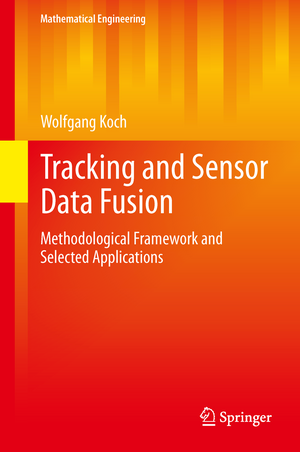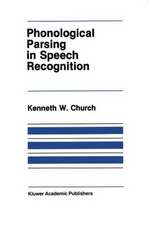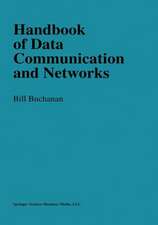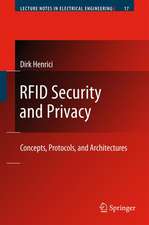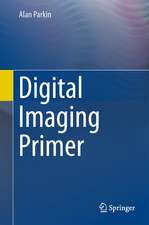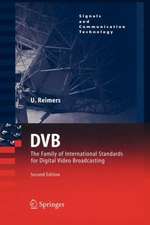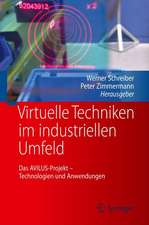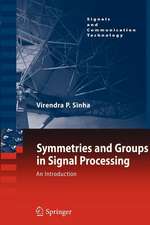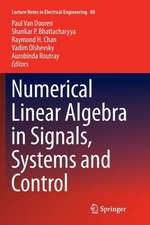Tracking and Sensor Data Fusion: Methodological Framework and Selected Applications: Mathematical Engineering
Autor Wolfgang Kochen Limba Engleză Hardback – 7 oct 2013
This book provides an introduction Sensor Data Fusion, as an information technology as well as a branch of engineering science and informatics. Part I presents a coherent methodological framework, thus providing the prerequisites for discussing selected applications in Part II of the book. The presentation mirrors the author's views on the subject and emphasizes his own contributions to the development of particular aspects.
With some delay, Sensor Data Fusion is likely to develop along lines similar to the evolution of another modern key technology whose origin is in the military domain, the Internet. It is the author's firm conviction that until now, scientists and engineers have only scratched the surface of the vast range of opportunities for research, engineering, and product development that still waits to be explored: the Internet of the Sensors.
| Toate formatele și edițiile | Preț | Express |
|---|---|---|
| Paperback (1) | 997.88 lei 6-8 săpt. | |
| Springer Berlin, Heidelberg – 23 aug 2016 | 997.88 lei 6-8 săpt. | |
| Hardback (1) | 1001.81 lei 6-8 săpt. | |
| Springer Berlin, Heidelberg – 7 oct 2013 | 1001.81 lei 6-8 săpt. |
Din seria Mathematical Engineering
- 18%
 Preț: 1120.99 lei
Preț: 1120.99 lei - 17%
 Preț: 360.48 lei
Preț: 360.48 lei - 18%
 Preț: 1024.08 lei
Preț: 1024.08 lei - 5%
 Preț: 1156.98 lei
Preț: 1156.98 lei - 18%
 Preț: 992.34 lei
Preț: 992.34 lei - 17%
 Preț: 398.73 lei
Preț: 398.73 lei - 18%
 Preț: 783.98 lei
Preț: 783.98 lei - 18%
 Preț: 945.79 lei
Preț: 945.79 lei - 15%
 Preț: 644.82 lei
Preț: 644.82 lei -
 Preț: 390.08 lei
Preț: 390.08 lei - 18%
 Preț: 780.19 lei
Preț: 780.19 lei - 18%
 Preț: 728.28 lei
Preț: 728.28 lei - 15%
 Preț: 592.21 lei
Preț: 592.21 lei - 15%
 Preț: 643.84 lei
Preț: 643.84 lei -
 Preț: 367.15 lei
Preț: 367.15 lei - 18%
 Preț: 779.57 lei
Preț: 779.57 lei - 15%
 Preț: 643.00 lei
Preț: 643.00 lei - 15%
 Preț: 644.30 lei
Preț: 644.30 lei - 15%
 Preț: 636.63 lei
Preț: 636.63 lei - 15%
 Preț: 644.30 lei
Preț: 644.30 lei - 18%
 Preț: 948.29 lei
Preț: 948.29 lei - 15%
 Preț: 651.19 lei
Preț: 651.19 lei - 15%
 Preț: 644.95 lei
Preț: 644.95 lei - 18%
 Preț: 1118.75 lei
Preț: 1118.75 lei - 15%
 Preț: 647.73 lei
Preț: 647.73 lei - 18%
 Preț: 725.75 lei
Preț: 725.75 lei - 18%
 Preț: 783.98 lei
Preț: 783.98 lei - 18%
 Preț: 1111.53 lei
Preț: 1111.53 lei -
 Preț: 390.25 lei
Preț: 390.25 lei - 18%
 Preț: 780.19 lei
Preț: 780.19 lei - 18%
 Preț: 1112.78 lei
Preț: 1112.78 lei - 18%
 Preț: 952.26 lei
Preț: 952.26 lei - 18%
 Preț: 780.68 lei
Preț: 780.68 lei - 15%
 Preț: 643.16 lei
Preț: 643.16 lei - 18%
 Preț: 729.53 lei
Preț: 729.53 lei - 18%
 Preț: 905.36 lei
Preț: 905.36 lei - 15%
 Preț: 641.20 lei
Preț: 641.20 lei - 15%
 Preț: 656.25 lei
Preț: 656.25 lei - 15%
 Preț: 650.37 lei
Preț: 650.37 lei - 18%
 Preț: 1001.65 lei
Preț: 1001.65 lei
Preț: 1001.81 lei
Preț vechi: 1221.72 lei
-18% Nou
Puncte Express: 1503
Preț estimativ în valută:
191.72€ • 208.18$ • 161.04£
191.72€ • 208.18$ • 161.04£
Carte tipărită la comandă
Livrare economică 22 aprilie-06 mai
Preluare comenzi: 021 569.72.76
Specificații
ISBN-13: 9783642392702
ISBN-10: 3642392709
Pagini: 260
Ilustrații: XVII, 253 p. 79 illus., 6 illus. in color.
Dimensiuni: 155 x 235 x 20 mm
Greutate: 0.5 kg
Ediția:2014
Editura: Springer Berlin, Heidelberg
Colecția Springer
Seria Mathematical Engineering
Locul publicării:Berlin, Heidelberg, Germany
ISBN-10: 3642392709
Pagini: 260
Ilustrații: XVII, 253 p. 79 illus., 6 illus. in color.
Dimensiuni: 155 x 235 x 20 mm
Greutate: 0.5 kg
Ediția:2014
Editura: Springer Berlin, Heidelberg
Colecția Springer
Seria Mathematical Engineering
Locul publicării:Berlin, Heidelberg, Germany
Public țintă
ResearchCuprins
Notion and Structure of Sensor Data Fusion.- Part I Sensor Data Fusion: Methodological Framework.- Objects and Sensors.- Bayesian Knowledge Propagation.- Sequential Track Extraction.- On Recursive Batch Processing.- Aspects of Track-to-Track Fusion.- Part II Sensor Data Fusion: Selected Applications.- Integration of Advanced Sensor Properties.- Integration of Advanced Object Properties.- Integration of Topographical Information.- Feed-back to Acquisition: Sensor Management.
Notă biografică
PD Dr. rer. nat. Wolfgang Koch studied Physics and Mathematics at RWTH Aachen. He is head of dept. “Sensor Data and Information Fusion” at Fraunhofer FKIE and published handbook chapters and numerous journal/conference articles. For the IEEE Trans. on AES, he is Associate Editor-in-Chief and Technical Editor. Moreover, he is Member of the Board of Directors of the International Society of Information Fusion. At Bonn University he holds a habilitation degree on “Applied Computer Science”.
Textul de pe ultima copertă
Sensor Data Fusion is the process of combining incomplete and imperfect pieces of mutually complementary sensor information in such a way that a better understanding of an underlying real-world phenomenon is achieved. Typically, this insight is either unobtainable otherwise or a fusion result exceeds what can be produced from a single sensor output in accuracy, reliability, or cost.
This book provides an introduction Sensor Data Fusion, as an information technology as well as a branch of engineering science and informatics. Part I presents a coherent methodological framework, thus providing the prerequisites for discussing selected applications in Part II of the book. The presentation mirrors the author's views on the subject and emphasizes his own contributions to the development of particular aspects.
With some delay, Sensor Data Fusion is likely to develop along lines similar to the evolution of another modern key technology whose origin is in the military domain, the Internet. It is the author's firm conviction that until now, scientists and engineers have only scratched the surface of the vast range of opportunities for research, engineering, and product development that still waits to be explored: the Internet of the Sensors.
This book provides an introduction Sensor Data Fusion, as an information technology as well as a branch of engineering science and informatics. Part I presents a coherent methodological framework, thus providing the prerequisites for discussing selected applications in Part II of the book. The presentation mirrors the author's views on the subject and emphasizes his own contributions to the development of particular aspects.
With some delay, Sensor Data Fusion is likely to develop along lines similar to the evolution of another modern key technology whose origin is in the military domain, the Internet. It is the author's firm conviction that until now, scientists and engineers have only scratched the surface of the vast range of opportunities for research, engineering, and product development that still waits to be explored: the Internet of the Sensors.
Caracteristici
Provides a self-contained, unified introduction to Bayesian sensor data fusion Covers comprehensively methodological aspects not covered by other textbooks Discusses advanced application examples from different areas not covered by other textbooks A guide to the latest research literature for graduate students, researchers, and practitioners Includes supplementary material: sn.pub/extras
